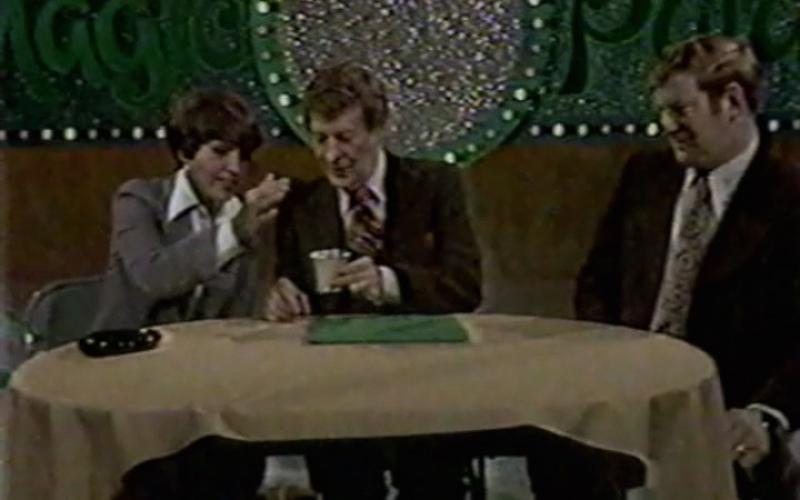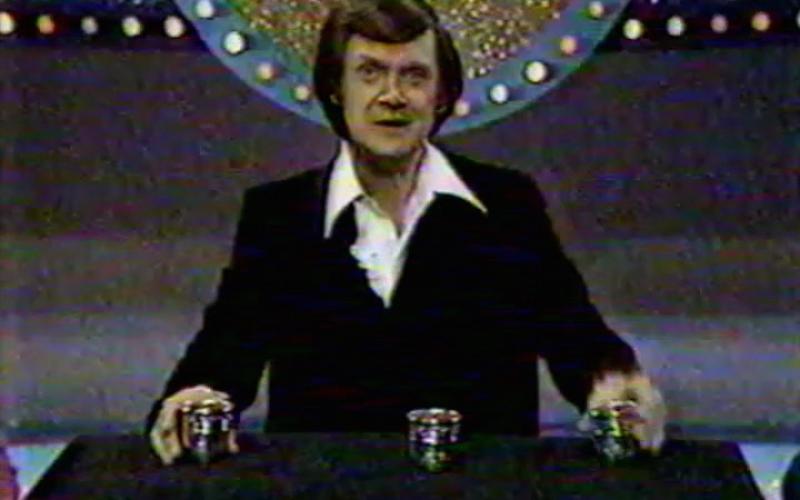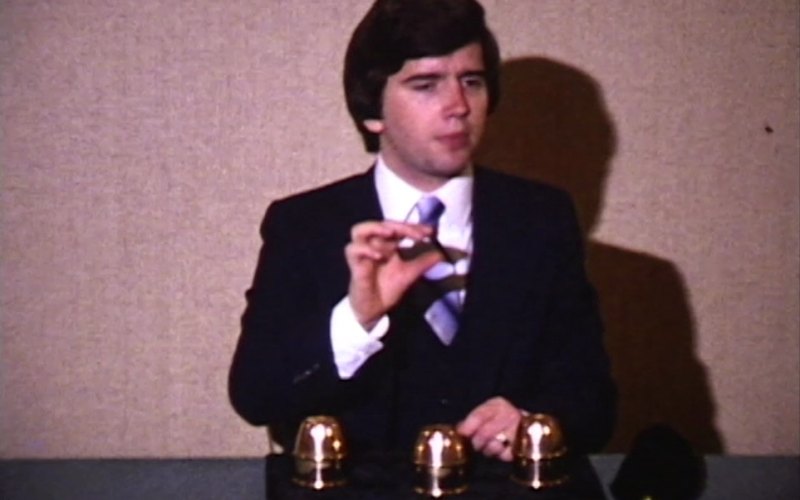Submitted by Jamy Ian Swiss on
I’ve found myself thinking a lot about the Cups and Balls lately. There are many reasons for this, not the least of which is my recent release of an instructional video for magicians, explaining my own routine that I’ve been performing for several decades and working on for most of my life. Because video is a limited medium for instruction, I also wrote an essay here in the Lyons Den just a few weeks ago that essentially consists of my accompanying “liner notes” to the video.
But that’s not all. The Magic of Johnny Thompson, a huge two-volume work I began writing with and for Johnny in 2003, was recently published by Magicana, and as of this week has essentially sold out, although it can presently still be found on some dealer’s shelves. The second volume begins with a 24-page section describe John Thompson’s routine with the Cups and Balls; elsewhere we devote 12 pages to his handling of the Roy Benson Bowl Routine, and we also talk about the cups in a segment about Dai Vernon’s Magic Castle act, and how and why Vernon—who created the most influential Cups-and-Balls routine of the 20th century—would typically open with the Cups and Balls, rather than close on it as some magicians are inclined to do.
When I began writing the Take Two series, in December of 2016, I started out with an essay about a single magical effect: the Torn and Restored Cigarette Paper. I also wrote an entry about the Linking Rings, but most of Take Two features individual performers, and occasionally some discussions of types of magic, such as manipulative magic, street magic, or grand illusion. But it does seem like the Cups and Balls is worthy of a closer look on its own, and indeed, Magicana hosts a marvelous online exhibition devoted entirely to the Cups and Balls, which among other segments offers a “Timeline of the Cups” that begins with a reference to an oft-cited hieroglyph in Beni Hasan, Egypt. (Links and more about this online exhibition later.)
Often said to be magic’s oldest trick—Dai Vernon often began his performances with that observation—there is actually some evidence for the truth of such a claim, but it’s unlikely that it’s the Cups and Balls that is depicted in Egyptian hieroglyphics. That oft-repeated trope seems to have begun with Milbourne Christopher’s Illustrated History of Magic, but the claim seems dubious and has been debunked by Egyptologists, who believe that the image in question actually depicts an act of baking. (Far be it from me to suggest that I’ve seen some versions of the Cups and Balls that about as exciting as watching bread rise.)
That said, however, we do have significant evidence of the trick’s significant age. The Roman Philosopher and dramatist Seneca the Younger describes the Cups and Balls (“acetabula et calculi”) in his 45th Epistle to Lucilius (probably written around 65 AD). That provides definitive evidence that magicians have been performing the Cups and Balls—and more importantly, perhaps, audiences have been watching and enjoying it—for some two millennia, at the very least. Interestingly, Seneca astutely observes that it is the mystery of the trick that engages him: “… it is the very trickery that pleases me. But show me how the trick is done, and I have lost my interest therein.”
The first book known to include an explanation of the Cups and Balls in English was The Discoverie of Witchcraft, published in England in 1584. Considered a classic work of Elizabethan literature, it is not actually a book about conjuring, but rather a book about witchcraft. The author, Reginald Scot, an intellectual landowner who studied law but did not practice, wrote the book as a rational examination of the witch trials and burnings of Jamesian England, albeit written before James I took the throne in 1603. It’s oft repeated that James declared the book heretical and ordered all copies burned, but this now seems to be unsupported.
The book remains important in many ways. One small note of interest is that it appears circumstantially likely that Shakespeare consulted it when reading up on witchcraft. The magic section refers to a trick called “Fast and Loose” (a phrase that would later become attached to a 19th century British street con game, also known as Pricking the Garter, today mostly seen in the hands of magicians), and Shakespeare invokes the same phrase three times in his plays. Today when we speak of playing fast and loose with the truth, we are reiterating a version of Shakespeare’s words, spoken by the character of King Philip in the 1595 play, King John, which refers to playing “fast and loose with faith.” And in 1598, in Loves Labours Lost, the character of Costard observes that, “To sell a bargain well is as cunning as fast and loose.”
But the main reason Scot’s Discoverie remains famous is because it is an early work reflecting skepticism of the Church of England and its supernatural claims—“discoverie” in the Old English usage meant explication of. While Scot does not deny the possible existence of witches, he focuses some of his argument on questioning the nature of the evidence submitted to bolster such charges. Thus I consider Scot’s work a legitimate work of skepticism, because rather than generalizing about the claims, he examines evidence—and that is the nature of scientific skepticism, namely, the attempt to determine the nature of evidence and thereby the definition of evidence-based truth.
The book, however, became unintentionally famous among magicians because of a 22-page chapter on the workings of magic. While Scot may have been something of an amateur magician himself (he doesn’t say so but I strongly suspect he was at least a casual enthusiast), with the assistance of a French born magician living in England named John Cautares, Scot described a number of popular magic tricks, explaining some of the workings, in an effort to demonstrate how easily people can be fooled by an experienced trickster—and thus calling into question how readily we may also be fooled in other contexts.
The book’s inadvertent fame is due to the fact that the magic chapter was subsequently lifted, copied, and republished, in whole, in part, or with additions, in numerous other examples of the early magic literature for the next century and a half to come. Indeed, because magic is comprised of a plethora of methods by which to accomplish a paucity of effects, many of the effects that Scot briefly described are still in use by magicians today, albeit in some (but not all) cases with updated methods. And of course, that includes the venerable Cups and Balls.
What accounts for the longevity of this classic? A recent survey has been touted that suggests that the public supposedly dislikes the classics of magic. The results of this survey mean—well, absolutely nothing to me, because the survey simply measures participants’ preconceived notions about magic. I, for one, have no interest in creating art based on random surveys or focus groups; I’ll leave that to lousy summer blockbuster movies. And while there’s no denying that some people have negative preconceived notions about magic—and indeed I have long built psychological strategies into my work that are deliberately intended to overcome that fact—all art is an act of education. As I quoted in my book Shattering Illusions, the filmmaker David Cronenberg has said, “An entertainer gives you exactly what you want. An entertainer gives you those good old songs that you want to hear. An artist gives you what you don’t know you want. Something you might know you want the next time, but you never knew you wanted before.”
My adolescent sons constantly bring preconceived notions to the movies and music I share with them. Overwhelmingly, most of the time they end up loving the movies and (at least sometimes!) appreciating the music. If I simply catered to their preconceptions they would never expand their tastes. Similarly, many of my personal partners have in the past expressed their dislike of some particular magic routine or other; one claimed to hate the Linking Rings, another the Cut and Restored Rope. My response was always nothing more than, “Uh-huh.” And then I’d wait patiently until they day they had the chance to see Bob Sheets do the Linking Rings or Mac King do his rope routine, and invariably the result was the same: “Oh, but that was great!” Who cares what people think of tricks in the abstract? I’ll tell you who: performers that cater to the audience’s whims rather than create a personal vision, giving the audience too much say in the outcome—a recipe for hackdom. What actually matters is the performer and the performance—and great magicians have always told us this. Al Goshman always said, “The magic is you.” Tom Mullica said he didn’t care if they remembered the trick, just so long as they remembered him.
And as to what people like to watch on YouTube, comparing this to who actually goes to live magic shows and why is like comparing apples to yo-yos. YouTube might tell you something about what people like to see on television, since the experience is somewhat analogous. But no experience is analogous for magic because we know and have long understood that magic is a uniquely live experience that becomes transformed and diluted via recorded media. The “stars” of YouTube magic are just that and that only: stars of YouTube magic. Great magicians? Successful magicians? Interesting artists? I’ll check off “none of the above.”
The fact that great magicians with actual live shows still perform the Cups and Balls with great success serves as the real testimony to its timeless appeal. And it’s not just seen at the Magic Castle—although it’s damned interesting to witness how so many different performers garner terrific reactions from audiences within the confines of those hallowed halls. Meanwhile, reviewing my entire log of Take Two essays, the following installments all include performances of the Cups and Balls:
Take Two #3 – Don Alan
Don Alan made this streamlined one-cup routine famous in the 1960s and beyond, performing it on The Ed Sullivan Show and The Tonight Show starring Johnny Carson, thereby fueling my passion for magic at a young age, having first been taught the routine by my first mentor, Louis Tannen.
Take Two #4 – Lance Burton
Although primarily a stage magician throughout his stellar career, Lance Burton did a terrific job with the Cups and Balls in one of his network television specials, with the help of Johnny Thompson, and a little bit from me.
Take Two #17 – Paul Gertner
Paul Gertner took the Dai Vernon routine and in his teens worked out his signature version using steel balls instead of the usual soft surfaced (and hence far quieter) crochet balls. Decades later he featured the routine in his second appearance on Penn & Teller’s “Fool Us!” series.
Take Two #24 & #25 – Street Magic
The Cups and Balls has been a staple of buskers for millennia, and in both parts of my Street Magic entries I featured fine contemporary examples, first from Cellini (Take Two 24) – who influenced a generation of street performers around the globe – and then from British street maestro Gazzo Magee (Take Two 25).
Read Take Two #24 Read Take Two # 25
Take Two #32 – Tommy Wonder
While Dai Vernon created what has become the standard model for the 20th century and beyond Cups and Balls, the one notable and radical departure is that of the late Tommy Wonder, one of the finest magicians of the late 20th century. Even those who have seen countless versions will find this version to be something quite different.
Take Two #52 - Dai Vernon
And then of course there is Dai Vernon, our 20th century maestro, who created the definitive and most influential approach, reviving the Cups and Balls for the 20th century.
You wouldn’t want to sit down and listen straight through to twenty version of “Stand By Me” or “Imagine,” two of the most “covered” songs in all of pop music, and I wouldn’t recommend trying to watch all of these takes on the Cups and Balls in a single sitting. But over a bit of time there is something enjoyable and instructive in this dramatic demonstration of the fact that “it’s never the song, it’s always the singer” (which also comprises the most cogent response to the above-cited survey), and so you might want to bookmark this page, and work your way through many or even most of these performances over the next few days or weeks. And yet, there are still other versions on YouTube that I thoroughly enjoy, each for their own reasons, and hence also highly recommend. Here are a few more:
Aside from Don Alan’s version in America, the definitive routine in the UK for the single-cup routine was devised by the revered performer and magic dealer, Ken Brooke. He taught it to a young man named Paul Daniels, who used it coming up as a performer in the challenging environs of the British “men’s clubs,” boisterous (to say the least) venues in which Daniels honed his performing chops, eventually becoming the most famous magician in England throughout the 1980s and ‘90s.
Paul Daniels - The Chop Cup
Although this period of their career is largely forgotten by the public and remains virtually unknown today to their younger television viewers, in the early days of Penn & Teller’s initial success they became notorious as “The Bad Boys of Magic” for allegedly “exposing” the workings of magic tricks. They didn’t really, but they convincingly pretended to, and even magicians fell for it for perhaps a decade or thereabouts. The routine that defined that approach was this one, performed with transparent cups, and for years was met with outrage by amateur magicians, much to Penn & Teller’s initial bafflement and longstanding delight.
Watch Penn & Teller: Cups & Balls
Hannibal is a contemporary performer who recently relocated to Los Angeles and can now often be seen performing at the Magic Castle, where his presence is unarguably an invaluable addition. I’m a fan of his work in general, and this marvelous performance in particular.
Hannibal: The Cups & Balls
Finally, the ever-inventive David Regal, a professional television comedy writer and prolific amateur magicians, talks in his performance about the version of the Cups and Balls that most of us began with, using colorful little plastic cups provided by the S.S. Adams Co, typically introduced via the childhood gift of a magic kit.
David Regal: Cups and Balls and Cups and Balls
All of which serve to bring us back to the marvelous online exhibition that exists here at Magicana, devoted entirely to the Cups and Balls. Sections include: a Timeline of the Cups; Inspired by the Cups; Variations on the Game; The Cups Online; Great Performances; and The Conjuror’s Perspective. I draw your attention particularly to these latter two areas. The Conjuror, in this case, is Magicana founder David Ben, himself a master of the Cups and Balls, and his four brief commentaries are thought provoking and informative. Then in Great Performances you will find five of the versions I have already addressed in Take Two, namely Don Alan, Dai Vernon, Paul Gertner, Gazzo, and Penn & Teller, however each is preceded by insightful introductions from Mr. Ben, and a sixth features Chicago bar performer Johnny Paul, providing yet another fine example of how a great performer can make the timeless trick his own, in this case a playful and interactive mini-program of fun and surprises.
Finally, I leave you with this: the Cups and Balls as performed by the inimitable Johnny Thompson. Widely acknowledged as our finest living American magician, John was taught the Cups and Balls by two of his own mentors, no less than the legendary Charlie Miller, along with Miller’s elder cohort, Dai Vernon himself. His remarkable routine in fact reflects a miniature history of 20th century Cups-and-Balls magic, as Thompson performs in character as three of its greatest practitioners: Max Malini, Pop Krieger, and Dai Vernon. The opening phase is indeed the creation of Max Malini, held secret for a century until at last seeing print in the recently published two-volume tome, The Magic of Johnny Thompson.
Recorded in the early 1980s in an appearance on the Canadian television series “Magic Palace,” and included as part of that show’s complete archive here at Magicana, please enjoy the Cups and Balls and the work of Max Malini, Pop Krieger, Dai Vernon, Charlie Miller, Jacob Daley, and above all, my own mentor, the inimitable Johnny Thompson.
Johnny Thompson: The Cups & Balls and "Chink-a-Chink"
SEE TAKE TWO INDEX










